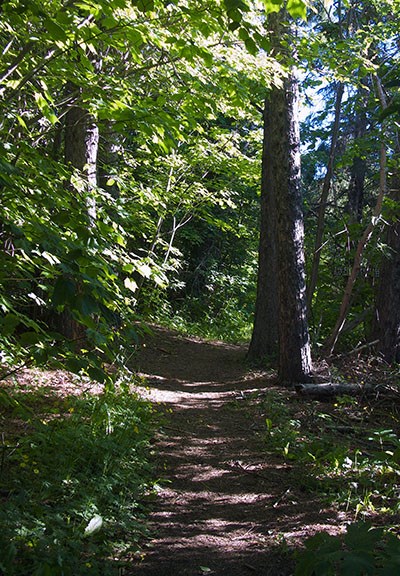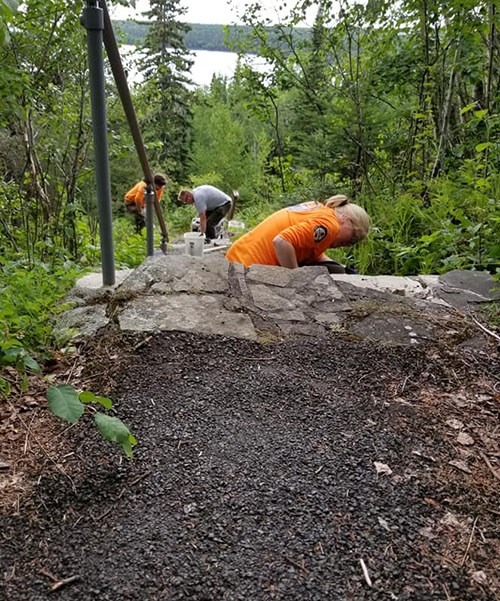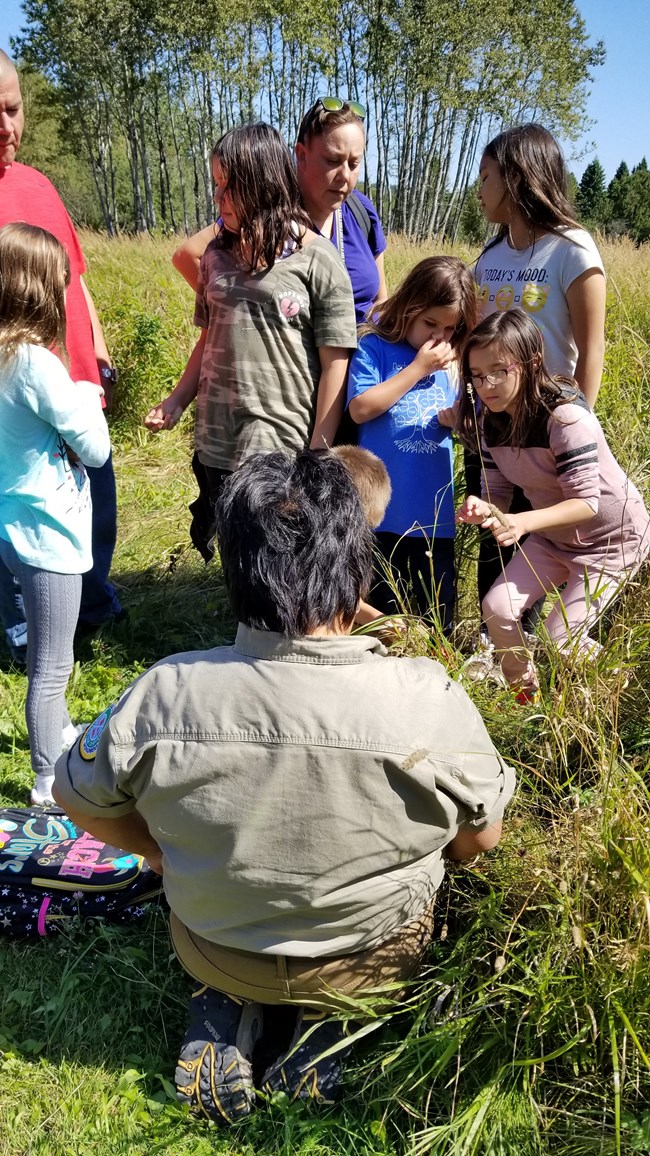Last updated: December 17, 2025
Article
Stewardship at Grand Portage National Monument
Great Carrying Place
The Grand Portage, or “Great Carrying Place,” was likely used by North American Indians for thousands of years prior to the arrival of Europeans in the eighteenth century. Gichi Onigaming is the Ojibwe term for this 8.5-mile trail route stretching from Grand Portage Bay along the shores of Lake Superior to the Pigeon River, which runs along the Minnesota/Ontario border. The land on the shore of Grand Portage Bay has been identified as a NPS cultural landscape through the section 110 process.

NPS Photo
The Grand Portage was a vital part of both American Indian and fur trade transportation routes because of the area’s geology, topography, natural resources, and strategic location between the upper Great Lakes and the interior of western Canada. In 1731, the French adopted the portage as a route to the Upper Country. After the end of the Seven Years War and the signing of the Treaty of Paris, the English began using the portage to transport supplies and furs in and out of warehouses at either end of the woodland trail. This commerce created a dynamic economic relationship between American Indian and non-Indian people during the eighteenth and early-nineteenth centuries.
Due to boundary controversy between Canada and the United States after the Second Treaty of Paris, the British learned of an alternate route along the Kaministiquia River from the Ojibwe tribe. This new route led to the abandonment of the Grand Portage by the British around 1804. During the mid-nineteenth century, the once-bustling international trade hub at Grand Portage Bay slowly evolved into a quiet seasonal haven for a small band of local Ojibwe Indians who relied on hunting, fishing, and trade for their livelihood.
In 1854, a treaty ceded most land associated with the Grand Portage Band of Lake Superior Chippewa to the United States government and led to the establishment of the Grand Portage Indian Reservation.
Grand Portage was designated a National Historic Site by the Secretary of the Interior in 1951. The documentation efforts of the area by federal, state, and local investigations increased the awareness of the region’s contribution to international history. Over the next seven years the National Park Service funded projects to improve visitor access to the site, including woodland clearing along the trail and installation of footbridges and walkways. In 1958, Congress authorized the establishment of Grand Portage as a federally owned and administered National Monument. This establishment included a donation of approximately half the land by the Grand Portage Band of Minnesota Chippewa (the Band) and the Minnesota Chippewa Tribe (MCT).
Since its establishment, the 710-acre national monument has interpreted and preserved the history of cross-cultural interaction and exchange among Ojibwe people and early Europeans during the eighteenth century expansion of the Great Lakes fur trading business. The National Park Service works closely with the Grand Portage Band of the Lake Superior Chippewa to support, interpret, and preserve the lifeways of the Ojibwe people, including the historic values of the Grand Portage trail.
Agreement
The Band has been involved with the management of the Monument, even before it was designated as a National Historic Site. They donated part of the land to the Monument, actively assisted in the writing and language of the enabling legislation - especially when it came to the rights of the tribes, and advocated strongly for an active role in Monument management (King 2007, 509).

NPS Photo
The Self-Governance Act was passed in 1994 after years of history and struggle between Indian tribes and the federal government. This Act gave tribes the authority to take over federal programs that serve or benefit the tribes themselves and provides funding for such efforts.
In 1999, under the Act, an agreement was made between the Grand Portage Band and the National Park Service that the maintenance of the National Monument would be done by Band employees. NPS maintenance employees there at the time had the choice to finish their careers within NPS or be shifted from the National Park Service to the Band.
Maintenance responsibility was an easy first step for the Band because they had experience and knowledge with past projects, since assisting in the reconstruction and restoration of the site as part of the Indian Division of the Civilian Conservation Corps (CCC-ID) in the 1930s. The Monument also bisects the reservation, and many tribe members were already working for the NPS in the maintenance division. The maintenance practices and skills needed in the Monument were not different than what was being done on the reservation.

Ralph Brown, NPS Photo / Grand Portage National Monument collection

NPS Photo
The agreement states that the maintenance staff will be hired by the Reservation Tribal Council, composed preferentially of Tribal members, and will conduct all maintenance practices in the Monument. However, since 1999, co-management of the park has extended to most other divisions. Band employees have now been hired in interpretation and resource management positions.
In 2018, the NPS and the Grand Portage Band created the Grand Portage Conservation Crew. This youth organization now serves resource management at Grand Portage National Monument, Grand Portage Reservation, and Isle Royale National Park. Examples of co-management practices and projects include: preservation of historic structures, ethnobotanical restoration, construction of a LEED platinum dormitory, archeological excavation at the Monument; wildland fire, timber stand improvement, and archeological survey on the Reservation; and moose browse surveys and exclosure construction on Isle Royale.
This agreement has led to a strong relationship where there is now a coordinated exchange of resources, ideas, and practices across jurisdiction and landscape boundaries. The relationship founded by this agreement fosters a greater and deeper connection of the Band and NPS with the landscape.
Ethnobotanical Restoration
Grand Portage National Monument has set out to work on ethnobotanical restoration. When the park first identified this project, they found guidance in M. Kat Anderson’s definition:
Ethnobotanical restoration is defined as reestablishing ethnobotanically significant plant communities of a given area along with the traditional and contemporary indigenous practices necessary to sustain them. Thus, this kind of restoration is not only about restoring plants, but also about restoring the human place within nature.
This type of restoration views restoring as never finished, but rather is about continuous interaction between people and plants. Renewing the relationship of plants and people in place may offer new and contemporary ways to coexist no less important to the heightened environmental awareness of self and place learned through traditional ecological knowledge (Anderson 2007, 18).

NPS Photo / Beth Drost
This definition was adopted as a way to set goals that address the importance of contemporary indigenous practices, and to achieve an outcome of reestablishing the relationship between people and plants in place into perpetuity. This thinking created space that allows the practice of ethnobotanical restoration at Grand Portage National Monument to grow and change alongside the relationship of people to plants.
Some examples of ethnobotanical restoration activity at Grand Portage are planting disease tolerant white pines to restore native biodiversity to the southern boreal forest, and using wildland fire use to facilitate sweetgrass management and harvest.
Grand Portage resource and maintenance staff have focused their ethnobotanical restoration efforts on the southern boreal forest. This plant community, comprised in part by white pine, black spruce, and tamarack, is native to the boreal forest and part of the Grand Portage Ojibwe culture for the last 300-400 years. The current ecosystem of pine, spruce, fir, and tamarack is in jeopardy of being disassociated and further interrupted by more southern species such as cherry, black oak, and white oak. The park thoroughly researched and proposed several options to address this problem so that the cultural and historical relationship between people and this plant community would not be lost. In 2016, the staff planted 700 white pine seedlings that are tolerant to blister rust.
Preservation of Historic Structures
The park maintenance staff have also worked to provide preservation treatment to historic structures in the park. During the 1930s, band members worked with the Works Progress Administration (WPA) and Civilian Conservation Corps – Indian Division (CCC-ID) to excavate and reconstruct structures such as the Great Hall and stockade. They also spent time constructing other supporting buildings like ranger stations and maintaining the Grand Portage trail.
In 1939, band members working with CCC-ID built a stone bridge across Grand Portage creek. This bridge signifies construction of critical infrastructure by Grand Portage Ojibwe community members that were participating in a nationally significant conservation works program. This stone bridge is a contributing feature of the Grand Portage National Monument historic district and is eligible on the National Register of Historic places. It is also a contributing feature of the cultural landscape.

NPS Photo
In 2015, a bridge inspection documented that the parapets, headwalls, and wingwalls of the bridge were leaning outward and that the mortar joints were cracking or missing. In 2018, the Grand Portage maintenance staff, Grand Portage Conservation Crew, Northern Bed Rock Conservation Corps, Grand Portage community members, and NPS Historic Preservation Training Center with their Tradition Trades Apprenticeship Program class successfully reconstructed both parapet walls and repointed the mortar joints of the headwalls and wingwalls.
Preserving the stone bridge is a great example of how generations of band members continue to be involved in the management, maintenance, and preservation of Grand Portage.
The stewardship of Grand Portage National Monument exemplifies the strengths of the agreement between tribe and park management. The Band and MCT’s active involvement in the ongoing preservation of the historic site bridges the landscape history and future.
Bahr Vermeer Haecker Architects. Grand Portage National Monument Cultural Landscape Report. Lincoln, Nebraska, 2009.
Hendricks, Melissa. "A Turnaround at Grand Portage: An Indian Tribe and a National Park Unit Find Common Ground." National Parks Magazine, 2008.
King, Mary Ann. "Co-Management or Contracting? Agreements Between Native American Tribes and the U.S. National Park Service Pursuant to the 1994 Tribal Self-Governance Act." Harvard Environmental Law Review 31, no. 2 (2007): 475-530.
National Park Service. Grand Portage National Monument Foundation Document. 2016.
National Park Service. Grand Portage National Monument Cultural Landscapes Inventory. 2005





